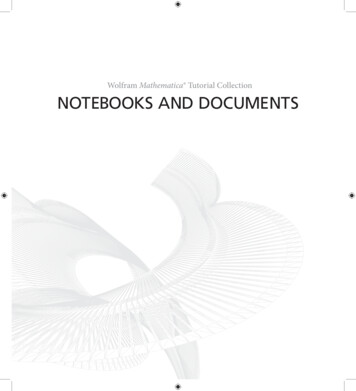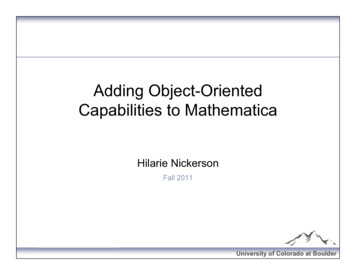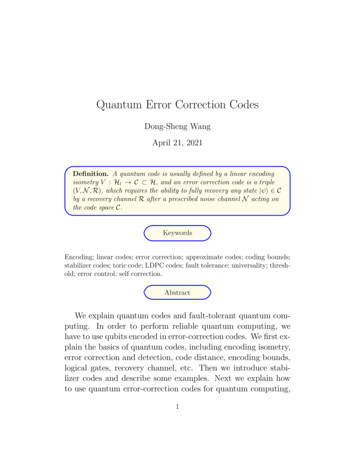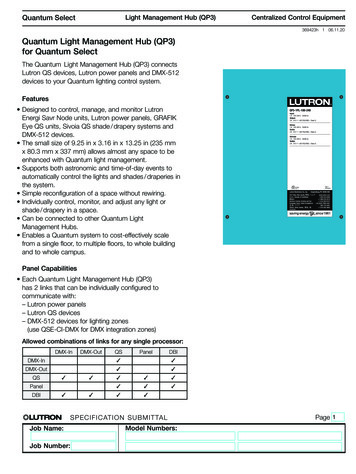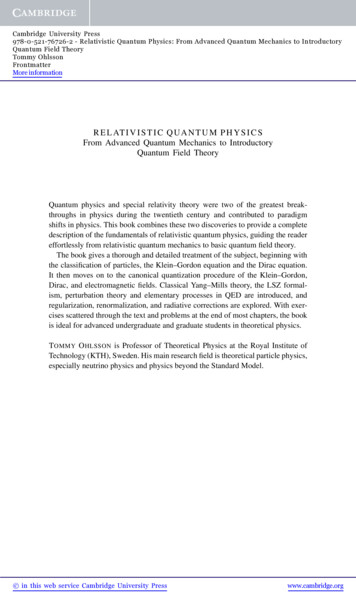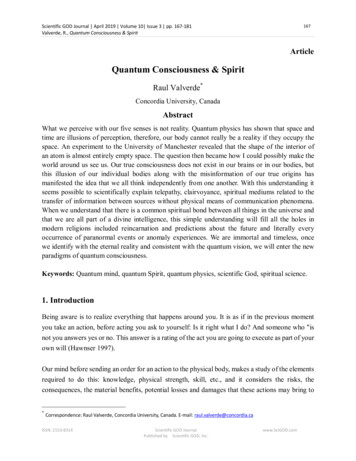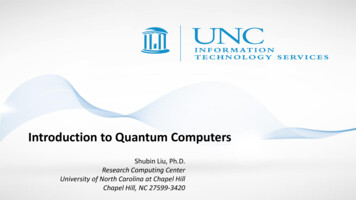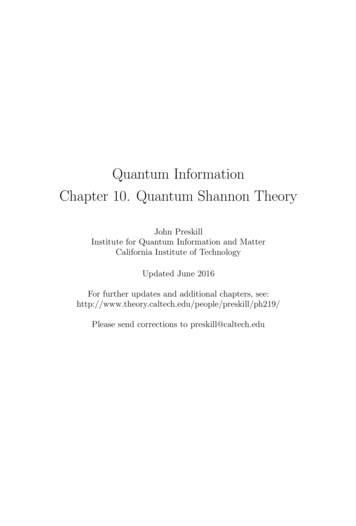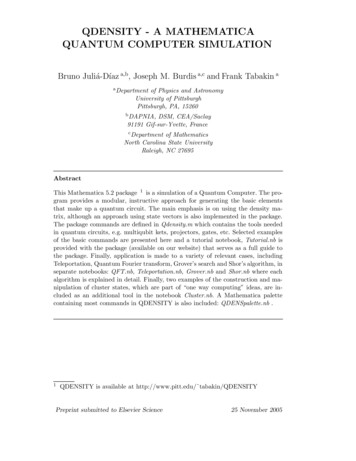
Transcription
QDENSITY - A MATHEMATICAQUANTUM COMPUTER SIMULATIONBruno Juliá-Dı́az a,b, Joseph M. Burdis a,c and Frank Tabakin aa Departmentof Physics and AstronomyUniversity of PittsburghPittsburgh, PA, 15260b DAPNIA,DSM, CEA/Saclay91191 Gif-sur-Yvette, Francec Departmentof MathematicsNorth Carolina State UniversityRaleigh, NC 27695AbstractThis Mathematica 5.2 package 1 is a simulation of a Quantum Computer. The program provides a modular, instructive approach for generating the basic elementsthat make up a quantum circuit. The main emphasis is on using the density matrix, although an approach using state vectors is also implemented in the package.The package commands are defined in Qdensity.m which contains the tools neededin quantum circuits, e.g. multiqubit kets, projectors, gates, etc. Selected examplesof the basic commands are presented here and a tutorial notebook, Tutorial.nb isprovided with the package (available on our website) that serves as a full guide tothe package. Finally, application is made to a variety of relevant cases, includingTeleportation, Quantum Fourier transform, Grover’s search and Shor’s algorithm, inseparate notebooks: QFT.nb, Teleportation.nb, Grover.nb and Shor.nb where eachalgorithm is explained in detail. Finally, two examples of the construction and manipulation of cluster states, which are part of “one way computing” ideas, are included as an additional tool in the notebook Cluster.nb. A Mathematica palettecontaining most commands in QDENSITY is also included: QDENSpalette.nb .1QDENSITY is available at http://www.pitt.edu/ tabakin/QDENSITYPreprint submitted to Elsevier Science25 November 2005
Program SummaryTitle of program: QDENSITYCatalogue identifier:Program summary URL: http://cpc.cs.qub.ac.uk/summariesProgram available from: CPC Program Library, Queen’s University of Belfast,N. IrelandOperating systems: Any which supports Mathematica; tested under MicrosoftWindows XP, Macintosh OS X, and Linux FC4.Programming language used: Mathematica 5.2Number of bytes in distributed program, including test code and documentation:Distribution format: tar.gzNature of Problem: Analysis and design of quantum circuits, quantum algorithms and quantum clusters.Method of Solution: A Mathematica package is provided which contains commands to create and analyze quantum circuits. Several Mathematica notebooks containing relevant examples: Teleportation, Shor’s Algorithm and Grover’ssearch are explained in detail. A tutorial, Tutorial.nb is also enclosed.2
Contents1INTRODUCTION42ONE QUBIT SYSTEMS62.1The Pauli Spin Operator92.2Pauli Operators in Hilbert Space122.3Rotation of Spin132.4One Qubit Projection153THE (SPIN) DENSITY MATRIX173.1Properties of the Density Matrix203.2Comments about the Density Matrix224MULTI -QUBIT SYSTEMS244.1Multi-Qubit Operators254.2General Multi -Qubit Operators274.3Multi-Qubit Density Matrix294.4Multi-Qubit States315CIRCUITS & GATES325.1One Qubit Gates335.2Two Qubit Gates345.3Three Qubit Gates376SPECIAL STATES386.1Uniform superposition386.2Bell States396.3GHZ States406.4Werner States417TELEPORTATION423
7.1One Qubit Teleportation427.2Two Qubit Teleportation438GROVER’S SEARCH448.1The Oracle458.2One marked item458.3Two marked items469SHOR’S ALGORITHM4610CLUSTER MODEL4811CONCLUSION49AThe QDENSITY palette50References152INTRODUCTIONThere is already a rich Quantum Computing (QC) literature [1] which holdsforth the promise of using quantum interference and superposition to solveotherwise intractable problems. The field has reached the point that experimental realizations are of paramount importance and theoretical tools towardsthat goal are needed: to gauge the efficacy of various approaches, to understand the construction and efficiency of the basic logical gates, and to delineateand control environmental decoherence effects.In this paper, a Mathematica [2] package provides a simulation of a QuantumComputer that is both flexible and an improvement over earlier such works [3].It is a bona fide simulation in that its success depends on quantum interference and superposition and is not just a simulation of the QC experience. Theflexibility is generated by a modular approach to all of the initializations, operators, gates, and measurements, which then can be readily used to describethe basic QC Teleportation [4], Grover’s search [5,6] and Shor’s factoring [7]algorithms. We also adopt a density matrix approach as an organizationalframework for introducing fundamental Quantum Computing concepts in amanner that allows for more general treatments, such as handling the dynamics stipulated by realistic Hamiltonians and including environmental effects.That approach allows us to invoke many of the dynamical theories based onthe time evolution of the density matrix. Since much of the code uses the4
density matrix, we call it “QDENSITY ,” which stands for Quantum computingwith a density matrix framework. However, the code also provides the tools towork directly with multi-qubit states as an alternative to the density matrixdescription.In section 2, we introduce one qubit state vectors and associated spin operators, including rotations, and introduce commands from QDENSITY . The basiccharacteristics of the density matrix are then discussed in a pedagogic mannerin section 3. Then in section 4, methods for handling multi-qubit operators,density matrices, and state vectors with commands from QDENSITY are presented. Also in that section, we show how to take traces, subtraces and howto combine subtraces with general projection operators to simulate projectivemeasurements in a multi-qubit context. The basic one, two and three qubitgates (Hadamard, CNOT, CPHASE, Toffoli, etc.) needed for the QC circuitsare shown in section 5. The production of entangled states, such as the twoqubit Bell [8] states, the three-qubit GHZ [9] states, among others, [10] areillustrated in both density matrix and state vector renditions in section 6. Insections 7-9, Teleportation, Grover’s search, and Shor’s factoring algorithmsare outlined, with the detailed instructions relegated to associated notebooks.Sample application to the cluster or “one-way computing” model of QC ispresented in section 10. Possible future applications of QDENSITY are given inthe conclusion section 11.The basic logical gates used in the circuit model of Quantum Computing arepresented in a way that allows ease of use and hence permits one to constructthe unitary operators corresponding to well-know quantum algorithms. Thesealgorithms are developed explicitly in the Mathematica notebooks as a demonstration of the application of QDENSITY . A tutorial notebook (Tutorial.nb)available on our web site guides the user through the requisite manipulations.Many examples from QDENSITY , as defined in the package file Qdensity.m, arediscussed throughout the text, which hopefully, with the tutorial notebook,will help the user to employ this tool.All these examples are instructive in two ways. One way is to learn howto handle QDENSITY for other future applications and generalizations, such asstudying entanglement measures, examining the time evolution generated byexperiment-based realistic Hamiltonians, error correction methods, and therole of the environment and its affect on coherence. Thus the main motivationfor emphasizing a density matrix formulation is that the time evolution can bedescribed, including effects of an environment, starting from realistic Hamiltonians [11,12]. Therefore, QDENSITY provides an introduction to methods thatcan be generalized to an increasingly realistic description of a real quantumcomputer.Another instructive feature is to gain insight into how quantum superposition5
and interference are used in QC to pose and to answer questions that would beinaccessible using a classical computer. Thus we can form an initial descriptionof a quantum multi-qubit state and have it evolve by the action of carefullydesigned unitary operators. In that development, the prime characteristics ofsuperposition and interference of probability amplitudes is cleverly applied inQuantum Computing to enhance the probability of getting the right answerto problems that would otherwise take an immense time to solve.In addition to applying QDENSITY to the usual quantum circuit model for QC,we have adapted it to examine the construction of cluster states and the stepsneeded to reproduce general one qubit and two qubit operations. These clustermodel examples are included to open the door for future studies of the quitepromising cluster model [13] or “one-way computing” approach for QC.We sought to simulate as large a system of qubits as possible, using newfeatures of Mathematica. Of course, this code is a simulation of a quantumcomputer based on Mathematica code run on a classical computer. So it isnatural that the simulation saturates memory for large qubit spaces; after all,if the QC algorithms always worked efficiently on a classical computer therewould be no need for a quantum computer.Throughout the text, sample QDENSITY commands are presented insections called “Usage.” The reader should consult Tutorial.nb formore detailed guidance.2ONE QUBIT SYSTEMSThe state of a quantum system is described by a wave function which in general depends on the space or momentum coordinates of the particles and ontime. In Dirac’s representation independent notation, the state of a system isa vector in an abstract Hilbert space Ψ(t) , which depends on time, but inthat form one makes no choice between the coordinate or momentum spacerepresentation. The transformation between the space and momentum representation is contained in a transformation bracket. The two representationsare related by Fourier transformation, which is the way Quantum Mechanicsbuilds localized wave packets. In this way, uncertainty principle limitationson our ability to measure coordinates and momenta simultaneously with arbitrary precision are embedded into Quantum Mechanics (QM). This fact leadsto operators, commutators, expectation values and, in the special cases whena physical attribute can be precisely determined, eigenvalue equations withHermitian operators. That is the content of many quantum texts. Our purpose is now to see how to define a density matrix, to describe systems withtwo degrees of freedom as needed for quantum computing.6
Spin, which is the most basic two-valued quantum attribute, is missing from aspatial description. This subtle degree of freedom, whose existence is deducedby analysis of the Stern-Gerlach experiment, is an additional Hilbert spacevector feature. For example, for a single spin 1/2 system the wave functionincluding both space and spin aspects is:Ψ( r1 , t) s ms ,(1)where s ms denotes a state that is simultaneously an eigenstate of theparticle’s total spin operator s2 s2x s2y s2z , and of its spin componentoperator sz . That iss2 sms h̄2 s(s 1) sms sz sms h̄ms sms .(2)For a spin 1/2 system, we denote the spin up state as sms 12 , 12 0 ,and the spin down state as sms 21 , 21 1 .We now arrive at the definition of a one qubit state as a superposition of thetwo states associated with the above 0 and 1 bits: Ψ a 0 b 1 ,(3)where a 0 Ψ and b 1 Ψ are complex probability amplitudes forfinding the particle with spin up or spin down, respectively. The normalizationof the state Ψ Ψ 1, yields a 2 b 2 1. Note that the spatialaspects of the wave function are being suppressed; which corresponds to theparticles being in a fixed location, such as at quantum dots. 2An essential point is that a QM system can exist in a superposition of thesetwo bits; hence, the state is called a quantum-bit or “qubit.” Although ourdiscussion uses the notation of a system with spin, it should be noted that thesame discussion applies to any two distinct states that can be associated with 0 and 1 . Indeed, the following section on the Pauli spin operators isreally a description of any system that has two recognizable states.2.0.1 UsageQDENSITY includescommands for qubit states as ket and bra vectors. For example, commands Ket[0], Bra[0],Ket[1], Bra[1], yield2When these separated systems interact, one might need to restore the spatialaspects of the full wave function.7
In[1] : Ket[0] 1 Out[1] : 0In[2] : Ket[1] 0 Out[2] : 1In[3] : Bra[0]Out[3] : (1 0)In[4] : Bra[1]Out[4] : (0 1)These are the computational basis states, i.e. eigenstates of the spin operatorin the z-direction.States that are eigenstates of the spin operator in the x-direction are invokedby the commandsIn[5] : BraX[0] 11Out[5] : 22which is equivalent to: In[6] : (Bra[0] Bra[1])/ 2 11Out[6] : 22Eigenstates of the spin operator in the y-direction are invoked similarly thecommands BraY[0], BraY[1], etc.8
2.1 The Pauli Spin OperatorWe use the case of a spin 1/2 particle to describe a quantum system withtwo discrete levels; the same description can be applied to any QM systemwith two distinct levels. The spin s operator is related to the three Pauli spinoperators σx , σy , σz byh̄(4) s ( ) σ ,2from which we see that σ is an operator that describes the spin 1/2 systemin units of h̄2 . Since spin is an observable, it is represented by a Hermitianoperator, σ † σ . We also know that measurement of spin is subject to theuncertainty principle, which is reflected in the non-commuting operator properties of spin and hence of the Pauli operators. For example, from the standardcommutator property for any spin [sx , sy ] ih̄sz , one deduces that the Paulioperators do not commute[σx , σy ] 2iσz .This holds for all cyclic components so we have a general form[σi , σj ] 2i ijk σk .(5)3(6)An important property of the spin algebra is that the total spin commutes withany component of the spin operator [s2 , si ] 0 for all i. The physical consequence is that one can simultaneously measure the total spin of the systemand one component (usually sz ) of the spin. Only one component is a candidate for simultaneous measurement because the commutator [sx , sy ] ih̄szis already an uncertainty principle constraint on the other components. As aresult of the ability to measure s2 and sz simultaneously, the allowed states ofthe spin 1/2 system are restricted to being spin-up and spin-down with respectto a specified fixed direction ẑ, called the axis of quantization. States definedrelative to that fixed axis are called “computational basis” states, in the QCjargon. The designation arises because as noted already one can identify spinup with a state 0 , which designates the digit or bit 0, and a spin-downstate as 1 , which designates the digit or bit 1.The fact that there are just two states (up and down) also implies propertiesof the Pauli operators. We construct 4 the raising and lowering operators3Here the Levi-Civita symbol is nonzero only for cyclic order of componentsijk xyz, yzx, zxy, for which ijk 1. For anti-cyclic order of componentsijk xzy, zyx, yxz ijk 1. It is otherwise zero.4 With the definition s s is , and using the original spin commutation rules, xyit follows that [s , sz ] s , which reveals that s and hence also σ are raising9
σ σx iσy , and note that the raising and lower process is boundedσ 0 0σ 1 0.(7)Hence, raising a two-valued state up twice or lowering it twice yields a null(unphysical) Hilbert space; this property tells us additional aspects of thePauli operator. Sinceσ σ (σx iσy )2 σx2 σy2 (σx σy σy σx ) 0,(8)we deduce that σx2 σy2 , and that the anti-commutator{σx , σy } σx σy σy σx 0.(9)The anti-commutation property is thus a direct consequence of the restrictionto two levels.The spin 1/2 property is often expressed as: s2 sms h̄2 s(s 1) sms 23 2h̄ sms h̄4 σ 2 sms . We have σ 2 3 σx2 σy2 σz2 2σx2 1, where4we use the above equality σx2 σy2 , and from the ẑ eigenvalue equation theproperty σz2 1, to deduce thatσx2 σy2 σz2 1.(10)Another useful property of the Pauli matrices is obtained by combining theabove properties and commutator and anti-commutator into one expressionfor a given spin 1/2 systemσi σj δij i ijk σk ,(11)where indices i, j, k take on the values x, y, z, and repeated indices are assumedto be summed over. For two general vectors, this becomes σ · B) A ·B i(A B) · σ .( σ · A)( (12) B η, a unit vector ( σ · η)2 1, which will be useful later.For AThese operator properties can also be represented by the Pauli-spin matrices,where we identify the matrix elements by 1 0 s m0s σz s ms 0 1 .(13)and lowering operators.The general result, including the limit on the total spin isps s ms s(s 1) ms (ms 1) s ms 1 .10
Similarly for the x and y component spin operators 0 sm0s σx s ms 1 1 0 0 sm0s σy sms These are all Hermitian matrices σi i i 0σi† . .(14)Also, the matrix realization for the raising and lowering operators are: 0 0 σ .2 00 2 σ 0 0(15)†Here σ σ .Note that these 2 2 Pauli matrices are traceless Tr[ σ ] 0, unimodular σi2 1and have unit determinant det σi 1. Along with the unit operator 1σ0 1 0 0 1 ,(16)the four Pauli operators form a basis for the expansion of any spin operator inthe single qubit space. For example, we can express the rotation of a spin assuch an expansion and later we shall introduce a density matrix for a singlequbit in the form ρ a b · σ a b n · σ to describe an ensemble of particlespin directions as occurs in a beam of spin-1/2 particles.In QDENSITY , we denote the four matrices by σi where i 0 is the unit matrixand i 1, 2, 3 corresponds to the components x, y, and z. To produce thePauli spin operators in QDENSITY , one can use either the Greek form or theexpression s[i].2.1.1 UsageQDENSITY includescommands for the Pauli operators. For example, there arethree equivalent ways to invoke the Pauli σy matrix in QDENSITY :In[7] : σy 0 i Out[7] : i 0 11
In[8] : s[2] 0 i Out[8] : i 0The third way is to use the commands Sigma0, Sigma1,Sigma2, or Sigma3.Note thatIn[9] : σ2 . KetY[0] KetY[0] 0 Out[9] : 0andIn[10] : σ2 . KetY[1] KetY[1] 0 Out[10] : 0confirm that KetY[0] and KetY[1] are indeed eigenstates of σy . Note thatthe · is used to take the dot product.2.2 Pauli Operators in Hilbert SpaceIt is often convenient to express the above matrix properties in the form ofoperators in Hilbert space. For a general operator Ω, using closure, we haveΩ XXnn0 n n Ω n0 n0 .(17)For the four Pauli operators this yields:σ0 0 0 1 1 σ1 0 1 1 0 σ2 i 0 1 i 1 0 σz 0 0 1 1 .(18)12
Taking matrix elements of these operators reproduces the above Pauli matrices. Also note we have the general trace propertyTr a b XnX n a b n n b n n a b a ,(19)where n is a complete orthonormal (CON) basis . Applying this trace ruleto the above operator expressions confirms that Tr[σx ] Tr[σy ] Tr[σz ] 0,and Tr[σ0 ] 2.5Another useful trace rule is Tr[ Ω a b ] b Ω a .2.3 Rotation of SpinAnother way to view the above superposition, or qubit, state is that a stateoriginally in the ẑ direction 0 , has been rotated to a new direction specifiedby a unit vector n̂ (nx , ny , nz ) (sin θ cos φ, sin θ sin φ, cos θ), as shown inFig. 1. 0 zθznηθyφy(a)x(b)xFig. 1. Active rotation to a direction n̂ (a); and active rotation around a vector η̂(b).The rotated spin state iφ/2 cos(θ/2)e n̂ cos(θ/2)e iφ/2 0 sin(θ/2)e iφ/2 1 sin(θ/2)e iφ/2 ,(20)is a normalized eigenstate of the operator nz σ · n̂ nx inynx iny nz cos θ sin θe iφ sin θeiφ cos θ .(21)We see that σ · n̂ n̂ n̂ .5For a CON basis, we have closurePn n n 1.13(22)
The half angles above reflect the so-called spinor nature of the QM state ofa spin 1/2 particle in that a double full rotation is needed to bring the wavefunction back to its original form.These rotated spin states allow us to pick a different axis of quantization n̂ foreach particle in an ensemble of spin 1/2 systems. These states are normalized n̂ n̂ 1, but are not orthogonal n̂0 n̂ 6 1, when the n̂ angles θ, φdo not equal the n̂0 angles θ 0 , φ0 .Special cases of the above states with spin pointing in the directions x̂ and ŷ are within phases: 1 1 0 1 x , 2 12 0 i 1 1 1 y .2 i2(23)Hilbert space versions are also shown above.Rotation can also be expressed as a rotation of an initial spin-up system aboutγa rotation axis η̂ by an angle γ. Thus an operator Rγ e i 2 σ ·η̂ , acting as Ψ Rγ 0 (24)can also rotate the spin system state to new direction. This rotation operatorcan be expanded in the formγRγ e i 2 σ·η̂ cosγγσ0 i sin σ · η̂,22(25)which follows from the property that ( σ · η̂)2 η̂ · η̂ i(η̂ η̂) · σ 1 . A specialcase of the state generated by this rotation Rγ 0 is a γ π/2 rotationabout the η̂ ŷ axis. Then the rotation operator isπππRπ/2 e i 4 σy cos σ0 i sin σy .44(26)Introducing the Pauli matrices, this becomesRπ/2 1 1 1 .2 1 114(27)
This rotation about an axis again yields the same result; namely, 1 1 1 1 1 1 1 Rπ/2 0 · .2 1 12 02 1(28)Similar steps apply for a rotation about the x̂ axis by γ π/2, which yieldsthe earlier y states.From normalization of the rotated state Ψ Ψ 0 Rγ† Rγ 0 0 0 1, we see that the rotation is a unitary Rγ† Rγ 1 operator.2.3.1 UsageThe trace of the Pauli operators is invoked inQDENSITY by:In[1] : Tr[σ2 ]Out[1] : 0Rotation about the X axis is represented byIn[2] : RotX[θ] CosOut[2] : h iθ2 iSinh iθ2 iSinCosh i h iθ2θ2 Commands for other directions are described in Tutorial.nb; see RotX[θ],RotY[θ], Rotqbit[vec,θ].2.4 One Qubit ProjectionFor a one qubit system, it is simple to define operators that project on to thespin-up or spin-down states. These projection operators are:P0 0 0 P1 1 1 .15(29)
These are Hermitian operators, and by virtue of closure, sum to oneThey can also be expressed in terms of the σz operator asP0 1 σz2P1 1 σz,2Pa 0,1Pa 1.(30)or in matrix form 1P0 0 0 0 0 0 P1 0 1 .(31)One can also project to other directions. For example, projection of a qubiton to the x̂ or ŷ directions involves the projection operators1 σx,21 σy.P y ŷ ŷ 2P x x̂ x̂ (32)2.4.1 UsageThe above projections operators are invoked inIn[1] : P0 1Out[1] : QDENSITY by: 0 0 0In[2] : P1 0 0 Out[2] : 0 1 Projection operators using the x-basis are invoked by:In[3] : PX[0] Out[3] : 12121212 16
In[4] : PX[1] Out[4] : 12 12 21 12 A general operator ProjG[a,vec] to project into a direction stipulated by aunit three vector vec, with a 0 or 1, is also provided. See Tutorial.nb for moreexamples. These operators are useful for projective measurements.3THE (SPIN) DENSITY MATRIXThe above spin rotated wave functions can be used to obtain the expectationvalue of some relevant Hermitian operator Ω Ω† , which represents a physicalobservable. Let us assume that a system is in a state labelled by α with a statevector α . In general the role of the label α could be to denote a spatialcoordinate (or a momentum), if we were considering an ensemble of localizedparticles. For the spin density matrix, we use α to label the various spindirections n̂.The average or expectation value of a general observable Ω is then α Ω α .This expectation value can be interpreted simply by invoking eigenstates ofthe operator ΩΩ ν ων ν ,(33)where ων are real eigenvalues and ν are the eigenstates, which are usuallya complete orthonormal basis (CON). The physical meaning of the eigenvalueequation is that if the system is in the eigenstate ν , there is no uncertainty Ω in determining the eigenvalue, e.g.( Ω)2 ν Ω2 ν ν Ω ν 2 ων2 ων2 0.(34)Using the eigenstates ν , we can now see the basic meaning of the expectation value, which is a fundamental part of QM. The eigenstates form a CONbasis. That means any function can be expanded in this basis and that thecoefficients can be obtained by an overlap integral. For example, in generalterms the completeness (C) allows the expansion Ψ Xνcν ν .(35)The OrthoNormal (ON) aspect is ν ν 0 δνν 0 . Thus ν 0 Ψ Xνcν ν 0 ν c ν 0 ,17(36)
reinserting this yields Ψ Xν ν Ψ ν Xν ν ν Ψ I Ψ .Thus we see completeness with orthonormality of the basis can be expressedin the closure formX ν ν I,(37)νwith I the unit operator in the Hilbert space.With closure (e.g. a CON basis), we can now see that the expectation valuebreaks in to a sum of the form α Ω α XXνXνν0 α ν ν Ω ν 0 ν 0 α ων ν α α ν Xνων Pαν .Here Pαν ν α α ν ν α 2 is the positive real probability ofthe state α being in the eigenstate ν . Hence we see that the quantumaverage or expectation value is a sum of that probability times the associatedeigenvalue ων over all possible values ν. That is the characteristic of a quantumaverage.As the next step towards the spin density matrix, consider the case that wehave an ensemble of such quantum systems. Each system is considered notto have quantum interference with the other members of the ensemble. Thatsituation can be realized by the ensemble being located at separate sites withnon-overlapping localized wave packets and also in the case of a low densitybeam, i.e. separated particles in the beam. This allows us to take a classicalaverage over the ensemble.Suppose that the first member of the ensemble is produced in the state α ,the next in α0 , etc. The ensemble average is then a simple classical average Ω Pα α Ω α Pα,Pα Pα(38)where Pα is the probability that a particular state α appears in the ensemPble. Summing over all possible states of course yields α Pα 1. The aboveexpression is a combination of a classical ensemble average with the quantummechanical expectation value. It contains the idea that each member of theensemble interferes only with itself quantum mechanically and that the ensemble involves a simple classical average over the probability distribution ofthe ensemble.18
We are close to introducing the density matrix. This is implemented by usingclosure and rearranging. ConsiderXα α Ω α Pα X Xα α m m Ω m0 m0 α Pα ,mm0(39)where m denotes any CON basis. Now rearrange the above toXα α Ω α Pα XX m0 α α m Pα m Ω m0 ,mm0 α(40)and then define the density operator byρ Xα α α Pα(41)and the associated density matrix in the CON basis m as m ρ m0 0α m α α m Pα . We often refer to either the density operatoror the density matrix simply as the “density matrix,” albeit one acts in theHilbert space and the other is an explicit matrix. The ensemble average cannow be expressed as a ratio of traces 6PTr[ρΩ],Tr[ρ] Ω (42)which entails the properties thatTr[ρ] Xm m ρ m αPα α α XXαXPαXm α m m α Pα 1,(43)αandTr[ρΩ] Xmm0 m ρ m0 m0 Ω m XXPα α m0 m0 Ω m m α αmm0αPα α Ω α ,X(44)which returns the original ensemble average expression.6The trace Tr is defined as the sum of the diagonal matrix elements of an operator,where a CON basis is used.19
3.1 Properties of the Density MatrixWe have defined the density operator by a sum involving state labels α forthe special case of a spin 1/2 system. The definitionρ Xα α α Pα(45)is however a general one, if we interpret α as the label for the possible characteristics of a state. Several important general properties of a density operatorcan now be delineated. The density matrix is Hermitian, hence its eigenvaluesare real. The density matrix is also positive definite, which means that all ofits eigenvalues are greater or equal to zero. This, together with the fact thatthe density matrix has unit trace, ensures that the eigenvalues are in the range[0,1].To prove that the density matrix is positive definite, consider a basis ν which diagonalizes the density operator so that ν ρ ν µν XαPα ν α α ν Xα(46)2Pα ν α 0.Here µν is the νth eigenvalue of ρ and both parts of the final sum above arepositive quantities. Hence all of the eigenvalues of the density matrix are 0and the density matrix is thus positive definite. If one of the eigenvalues isone, all the others are zero.Another general property of the density matrix involves the special case of apure state. If every member of the ensemble has the same quantum state, thenonly one α (call it α0 ) appears and the density operator becomes ρ α0 α0 .The state α0 is normalized to one and hence for a pure state ρ2 ρ. Using a basis that diagonalizes ρ, this result tells us that the eigenvalues satisfyµν (µν 1) 0 and hence for a pure state one density matrix eigenvalues is 1,with all others zero.In general, an ensemble does not have all of its members in the same state,but has a mixture of possibilities as reflected in the probability distributionPα . In general, as we show below, we haveρ2 ρ,(47)with the equal sign holding for pure states. A simple way to understand thisrelationship is seen by transforming the density matrix to diagonal form, usingits eigenstates to form a unitary matrix Uρ . We have Uρ ρUρ† ρD , where ρDis diagonal using the eigenstates of ρ as the basis, e.g. ν ρD ν 0 µν δνν 0 .20
Here µν again denotes the νth eigenvalue of ρ. We already know that the sumof all these eigenvalue equals 1, that they are real and positive. Since everyeigenval
Windows XP, Macintosh OS X, and Linux FC4. Programming language used: Mathematica 5.2 . 2 ONE QUBIT SYSTEMS The state of a quantum system is described by a wave function which in gen-eral depends on the space or momentum coordinates of the particles and on time. In Dirac's representation independent notation, the state of a system is
